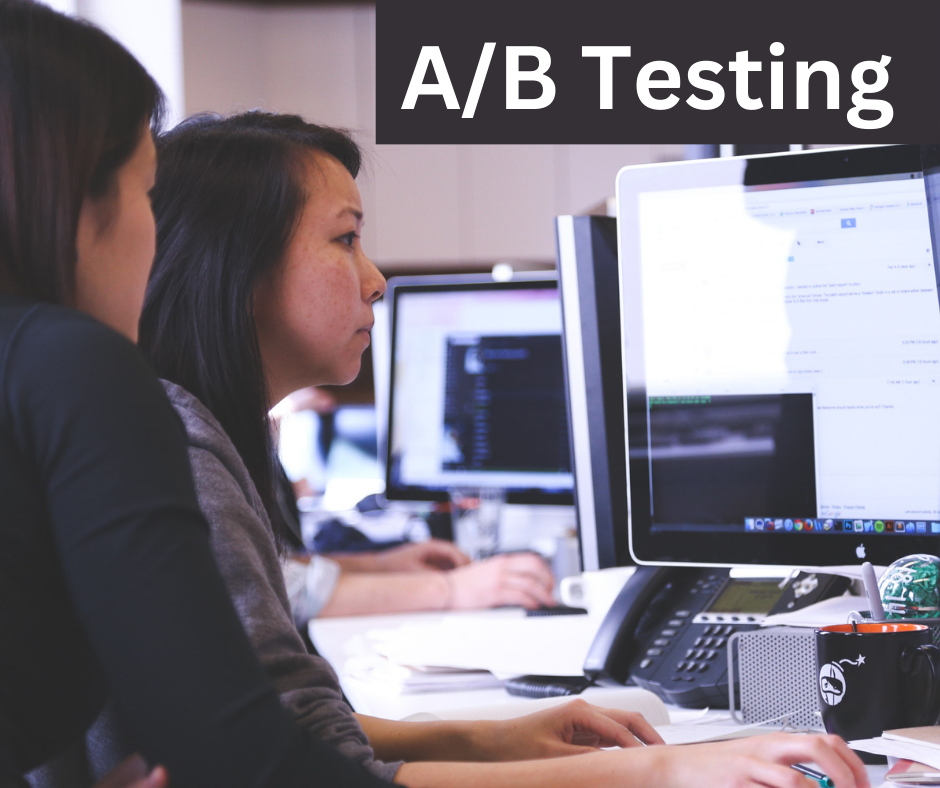A/B testing in digital marketing also known as Split Testing, is a technique for comparing the effectiveness of two or more variations of a marketing component, such as an email campaign, a web page, an advertisement, or a landing page. Finding which variation performs better in terms of a certain key performance indicator (KPI), such as click-through rates, conversion rates, or revenue, is the main goal of A/B testing.
How does A/B testing work?

Objective Definition:
For an A/B test, you must first specify a precise and measurable aim. This can involve boosting user engagement, lowering bounce rates, improving conversion rates, or raising click-through rates.
Variation Creation:
The website or app component you want to test should be created in two or more variations. The control group (version A), which stays the same, and the test group (version B), where you make a certain change, are the two versions. This modification could entail altering the color of a button, the headline, or the layout.
Random Assignment:
Users or visitors are randomly assigned to either group A or group B. This randomization helps ensure that the groups are statistically similar in terms of user characteristics, reducing bias.
Data Collection:
Users see both versions of the website or application at once. For both groups, information is gathered on user interactions and conversions. Tools like Google Optimize, Optimizely, or customized analytics solutions can be used for this.
Statistical Analysis:
You do statistical analysis to see if there is a significant performance difference between the two groups after gathering enough data. You can determine which version is more successful at attaining your desired outcome using this analysis.
Implementation
If the test version (B) performs noticeably better than the control version (A), you may decide to apply the modifications to your website or app to boost performance. You can repeat the exam or attempt an alternative strategy if there isn’t a discernible difference.
Repeat
The process of A/B testing never ends. To get better results, you can regularly test and adjust various components of your website or app.
Common applications of A/B testing in digital marketing include:

Email Marketing:
Testing subject lines, email content, call-to-action buttons, and more to improve open rates and click-through rates.
Website Optimization:
Testing different versions of landing pages, product pages, or forms to increase conversion rates.
Advertising:
Testing ad creatives, ad copy, and targeting parameters to improve ad campaign performance.
Content Marketing:
Testing headlines, images, and content layouts to enhance engagement and time spent on a page.
E-commerce:
Testing product descriptions, pricing strategies, and checkout processes to boost sales and revenue.
A/B Testing Goals

Conversion Rate Optimization:
Increasing conversion rates is one of the most popular objectives. This could entail increasing the proportion of website visitors who complete a form, make a purchase, sign up for a newsletter, or engage in another targeted action.
Click-Through Rate (CTR) Improvement:
In a variety of situations, such as email marketing, online advertising, or call-to-action buttons on a website, A/B testing can be used to increase click-through rates.
Revenue Increase:
For e-commerce websites, the goal might be to boost revenue by testing different product page layouts, pricing strategies, or checkout processes.
User Engagement:
A/B testing can boost user engagement by encouraging visitors to stay on a website longer, read more information, or use particular features.
Reducing Bounce Rate:
A/B testing can be used to improve landing pages or websites by lowering bounce rates, which is the proportion of users who leave the site right away without interacting.
Email Open Rate:
For email marketing, the goal might be to improve the open rate of email campaigns by testing different subject lines, sender names, or send times.
Ad Click-Through Rate (CTR):
By experimenting with various ad creatives, ad wording, pictures, and targeting settings to raise the click-through rate, A/B testing can aid in the optimization of online advertising campaigns.
Lead Generation:
Improving lead generation efforts by testing lead capture forms, lead magnets, and their placements on a website.
Cost Reduction:
A/B testing may occasionally be used to minimize expenses without sacrificing effectiveness, such as when lowering the cost per click (CPC) in advertising campaigns without lowering conversion rates.
User Experience Enhancement:
Improving the user experience by testing different user interface designs, navigation menus, or content layouts.
Mobile Responsiveness:
By testing mobile versions of websites or apps, ensuring that web components are mobile-friendly.
Personalization:
Tailoring content or recommendations to individual users based on their behavior and preferences.
Content Performance:
Testing different types of content, formats, or content delivery strategies to determine what resonates best with the audience.
Brand Awareness:
Increasing brand visibility and awareness by testing ad campaigns or content strategies.
Segmentation:
To determine which message best appeals to each audience demographic, multiple messaging is being tested.
How to Read A/B Testing Results
Understanding the effects of the changes you’ve made in a test requires reading and interpreting the results of A/B testing. Here is a step-by-step tutorial on how to interpret A/B testing results:
Define Key Metrics:
You should have a clear definition of the key performance indicators (KPIs) you wish to track before beginning the A/B test. These might consist of revenue, engagement metrics, click-through rates, conversion rates, or any other pertinent indicators. Ensure that data on these KPIs has been gathered for both the test group (B) and the control group (A).
Access the Data:
Assemble the A/B test data that was gathered. The outcomes for each variation in terms of the chosen KPIs are included in this data. You might also be aware of the sample size, the length of the test, and any other pertinent data points.
Statistical Significance:
Identify the statistical significance of the results. You can determine if the observed differences between the variations are not the result of chance using statistical significance. The usual thresholds for statistical significance are 95% or 99%. If the results are statistically significant at the level you’ve selected, you can be sure your modifications really did have an effect.
Analyze the Metrics:
Examine the data for every variant to see how it did in relation to the KPIs. To acquire a full picture of the impact, take into account both secondary measurements and the core KPI. Analyze the data for patterns and trends.
Comparison of Variations:
Compare the test group’s (B) performance to that of the control group’s (A) performance. Take into account elements like the degree of the change and the impact’s direction (i.e., whether the change had a positive or negative effect).
Effect Size:
Determine the effect size, if necessary. A concrete grasp of the effects of the modifications is provided by the effect size, which quantifies the size of the differences between the variations.
Practical Significance:
Think about whether the observed disparities have any real-world implications. Even though a change is statistically significant, it could not have any real-world significance. Determine whether making the adjustments is worthwhile.
Additional Analysis:
You might want to conduct additional analysis if the results are not what you expected or if you need more information. This may entail doing follow-up tests to gauge the effects of various variables or segmenting the data to determine whether particular user groups reacted differently.
Consideration of External Factors:
Be mindful of any external factors that might have influenced the results. Seasonal trends, market changes, or other events can impact outcomes.
Documentation:
Create a report of the findings that includes the data, statistical significance, analysis, and any suggestions. With team members or stakeholders, this documentation may be helpful for reporting and sharing ideas.
Action Steps:
Choose the best course of action based on the analysis and outcomes. Consider making the adjustments if the test variation (B) performed better than the control variation (A). Consider possible next measures, such as improving the test or attempting a different strategy, if there is no discernible difference or a negative effect.
Continuous Learning:
The process of A/B testing never ends. Utilize the information you gain from each test’s findings to guide your future testing and optimization efforts.
